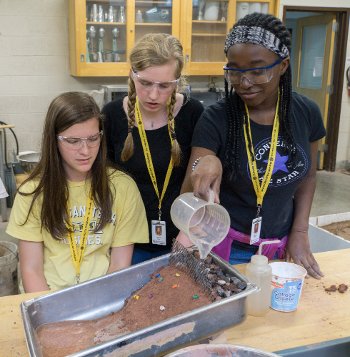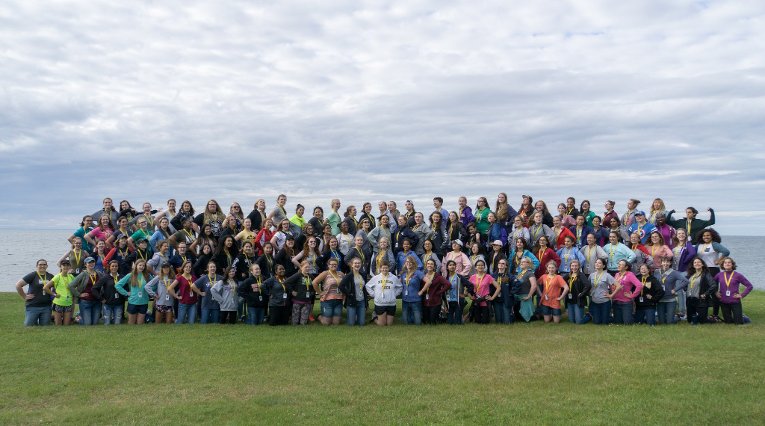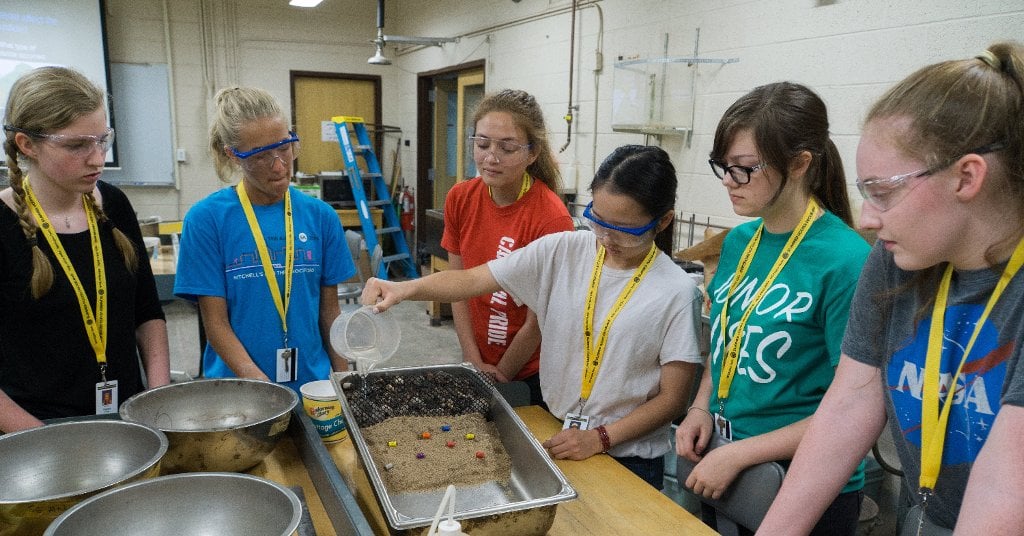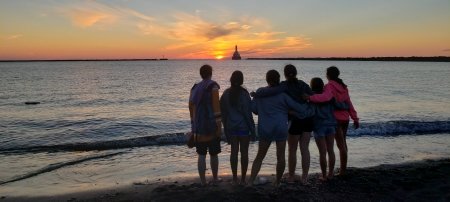From bath bombs to software code to prosthetic tests to landslide models, these students get their hands dirty learning about science, tech, engineering and math.
This week, 120 students from around the nation explore different engineering fields as part of the Women in Engineering course, a scholarship program offered through Michigan Technological University's Summer Youth Programs (SYP).

And they're ready to take STEM by a landslide.
Quite literally. Avery Londo of Colombus, Ohio, Maggie Asare of Houston, Texas, and Dakota Barnes of Kalamazoo, Michigan, start a landslide in Dillman Hall. They pour water down the steep slope of piled clay, silt and sand in a tin pan, decorated with little toy houses. It's part of a geological engineering class. They pour a little more, and the slope starts to give way, the bottom layers turning to pudding as the top starts to slump.
The three students say they're excited to be in engineering classes. When asked which one they're looking forward to the most, they read off pretty much whole the SYP syllabus.
"I know that I want to be an engineer. I'm here to find out what kind of engineering I want to pursue."
Their teachers for the week—faculty and grad students on campus for the summer—say tapping into that enthusiasm is key to fostering future scientists.
Ingredients of Success
ChemStores got an exciting request last month: 60 pounds of Epsom salts, two gallons of vegetable oil, 40 pounds of baking soda, another 40 pounds of shortening, and a 50-pound bag of corn starch.
Why? Slime and bath bombs.
The two materials are part of lessons that Scott Wendt, the manager of lab facilities in chemical engineering, put together for his SYP groups this summer.
"These lessons are not one-to-one," Wendt says, explaining that equations and complexity don't translate perfectly into high school lesson plans. "We take liberty with some of the science to get the concept down."
The bath bombs exercise covers stoichiometry and how changing the quantity of one ingredient can change the whole reaction; slime shows how long chains of molecules are built up in polymerization; rock-salt ice cream is a tasty exercise in thermodynamics.
"We have to let the kids get their hands dirty—that's what science is about," Wendt says. "So many high school students are taught to take a test. SYP picks up where those classrooms leave off, and that's why more and more money needs to be funneled into these programs."
"I left my engineering job to go teach high school. There's something about seeing the light turn on in a student's eyes that makes it all worthwhile."
To STEM and Beyond
Asare, Barnes and Londo sit together at lunch along with Grace Liu and Paige Hill, both from the local area. Their enthusiasm is contagious—as is their conviction for a bright future where STEM jobs are an important part of the US workforce. Yet it's still daunting when STEM workplaces remain male-dominated.
The National Science Foundation reports in its Science and Engineering Indicators 2016 that women represent 15 percent of the engineering workforce. Women of ethnic and racial minorities have even less representation. While young girls are subjected to gender bias that may prevent them from pursuing STEM careers, there is no difference between boys' and girls' aptitude for science; the numbers drop off later as women enter and leave the STEM workforce.
These statistics don't halt the lunchroom conversation, even though the talk becomes more thoughtful. For the most part, the students say they're willing to rise to any challenge ("I like being one of the few girls in class, I usually whoop the boys anyway," Londo admits) and advocate for more gender-neutral treatment ("It's an opportunity to work together and bring in new perspectives; the best classes have mixed genders," Liu says).
To them, the bottom line is that they want their work to matter, and they see engineering as an opportunity to contribute to the greater good.
"I like applying science—you're doing something that makes a difference."
The Women in Engineering course gives students a taste of engineering and the tools to move forward in STEM. Some skills can be learned in a classroom, others have to be internalized. At the traditional Monday night cookout held at McLain State Park, the SYP students all gathered with Lake Superior as a backdrop. They struck a power pose and shouted out, "I will attack this day with enthusiasm and confidence unknown to mankind."

Michigan Technological University is an R1 public research university founded in 1885 in Houghton, and is home to nearly 7,500 students from more than 60 countries around the world. Consistently ranked among the best universities in the country for return on investment, Michigan's flagship technological university offers more than 185 undergraduate and graduate degree programs in science and technology, engineering, computing, forestry, business, health professions, humanities, mathematics, social sciences, and the arts. The rural campus is situated just miles from Lake Superior in Michigan's Upper Peninsula, offering year-round opportunities for outdoor adventure.






Comments